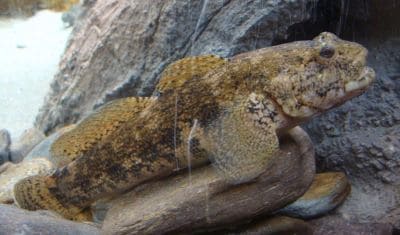Home › Sea Life › Marine › Vertebrates › Gobies › Giant Goby
Facts about the Giant Goby Fish
[Phylum: Chordata] [Class: Actinopterygii] [Order: Gobiiformes] [Family: Gobiidae]
Despite its small eyes and short tail, this particular fish family is better known for being the largest goby found at rocky shorelines around the United Kingdom.
This section contains fun facts and interesting information about the giant goby (Gobius cobitis), including where they live, what they eat, and how they reproduce.
Giant Goby Habitat and Geographic Range
There are only a few select places around the world where you can find giant gobies (scientific name Gobius cobitis).
You can spot them at the coastal marine and brackish waters of the:
- Black Sea
- Eastern Atlantic (e.g. Morocco)
- Mediterranean Sea (including the Gulf of Suez)
- South coast of the United Kingdom
- Western English Channel
In fact, giant gobies thrive best among the rocks and boulders of intertidal zones. Often, these sheltered rockpools receive regular flows of fresh water which tends to produce a brackish environment.
Because of this, most of these macrobenthos feeders live in depths ranging from ten (10) to thirty five (35) metres (115 feet).
Giant Goby Size and Characteristics
Gobius cobitis is a medium sized ray-finned fish that most marine biologists consider to be the largest of all gobies in the world. In fact, fully grown adults measure up to twenty seven (27) centimetres long (11 inches).
Despite being small, its eyes are widely spaced (when compared with other goby fish species). A large head, short tail stem, and deep, chunky body also help to distinguish it from its smaller relatives (e.g. dwarf pygmy gobies).
Here's the thing:
If there is one standout feature of the giant goby, it is its colouring. The grey to olive brown tapered body produces an appearance of 'salt and pepper' speckling that combines nicely with the dark blotches that run along its lateral midline.
This harmless giant of the rocky shorelines is the largest of all gobies in Britain. In fact, it will spend most of the day sheltering underneath overhangs and hiding inside crevices.
What Do Giant Gobies Eat?
Having a small size throat, and relatively poor vision for a fish, gobies tend to snack on small meals. As a result, the typical animal and plant-based food sources that the giant goby fish eat, usually includes:
- Amphipods (shell less malacostraca crustaceans)
 Brine shrimp nauplii
Brine shrimp nauplii- Crabs species (Brachyura)
- Crustaceans
- Green algae (Ulva intestinalis)
- Juvenile fishes
- Plankton
- Plant and vegetable detritus
- Polychaete worms and insects
- Zooplankton
Pro Tip: Our fishkeeping for beginners guide contains more information about taking care of gobies fishes as pets in aquariums.
Giant Goby Reproduction Process
It's quite easy to spot the breeding males because they have darker body colours than the females - especially the small, scaly specimens.
Research suggests that females will lay up to twelve thousand eggs. Following that, the main role of the male is to guard them while they develop in the nest (e.g. a small crevice).
Threats and Predators
The giant goby is a rare marine species protected under the 'Wildlife and Countryside Act 1981' in Great Britain. In other words, it is a criminal offence to disturb giant goby species or to cause damage to their rock pool habitats.
Important: The Act of Parliament makes it an offence to injure, take, sell, or kill giant gobies. If you catch a giant goby (e.g. while fishing or rock pooling), you must put it back in the water without delay and report it to the local Wildlife Trust.
Related Information and Help Guides
- Blennies Fish Facts and Species Information
- Dwarf Pygmy Goby Fun Facts and Information
- Red Fire Goby Fun Facts and Information
- Fun Facts and Information about Flashlight Fish
- Yellow-Prawn Goby Fun Facts and Information
- Violet Goby Dragon Fish Facts and Information
Note: The short video [3:23 seconds] presented by 'GHMarineBio' contains fun and interesting footage about the UK's rarest fish - the giant goby (Gobius cobitis).